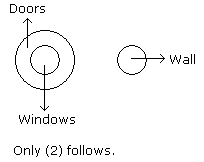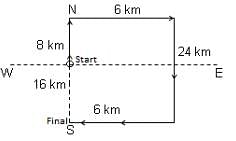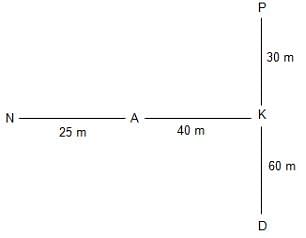SSC CGL (Tier II) Practice Test - 18 - SSC CGL MCQ
30 Questions MCQ Test SSC CGL Tier II Mock Test Series 2025 - SSC CGL (Tier II) Practice Test - 18
A Special pump can be used for filling as well as for emptying a Cistern. The capacity of the Cistern is 2400m³. The emptying capacity of the Cistern is 10m³ per minute higher than its filling capacity and the pump needs 8 minutes lesser to Cistern the tank than it needs to fill it. What is the filling capacity of the pump?
Directions to Solve
Choose the correct alternative that will continue the same pattern and replace the question mark in the given series.
Question -
24, 60, 120, 210, ?
Prakash, Qureshi, Rajesh and Shabdesh live together in a house.
1. Prakash lives with his (or her) parents.
2. Qureshi lives with at least 3 persons younger than him (or her).
3. Shabdeesh lives with his mother and is older than at least 2 persons living with him.
4. Rajesh lives with his (or her) son and is not older than Shabdeesh.
Qureshi is Prakash’s ______.
Directions to Solve
In each of the following questions find out the alternative which will replace the question mark.
Question -
Flow : River :: Stagnant : ?
Directions to Solve
In each of the following questions two statements are given and these statements are followed by two conclusions numbered (1) and (2). You have to take the given two statements to be true even if they seem to be at variance from commonly known facts. Read the conclusions and then decide which of the given conclusions logically follows from the two given statements, disregarding commonly known facts.
Give answer:
- (A) If only (1) conclusion follows
- (B) If sonly (2) conclusion follows
- (C) If either (1) or (2) follows
- (D) If neither (1) nor (2) follows and
- (E) If both (1) and (2) follow.
Question -
Statements: All the windows are doors. No door is a wall.
Conclusions:
- Some windows are walls.
- No wall is a door.
Martin starts from his house and walks 8 km towards North. From there, he takes a right turn and walks 6 km. Then, he turns right and walks 24 km. He again takes a right turn and walks 6 km. How far is he from his house?
Directions: Study the information given below carefully and answer the question that follows.
In a playground, Dinesh, Kunal, Nitin, Atul and Prashant are standing, as described below, facing north.
(i) Kunal is 40 metres to the right of Atul.
(ii) Dinesh is 60 metres to the south of Kunal.
(iii) Nitin is 25 metres to the west of Atul.
(iv) Prashant is 90 metres to the north of Dinesh.
Q. If a boy walks from Nitin, meets Atul followed by Kunal, Dinesh and then Prashant, provided that he has travelled a straight distance all through, how many metres has he walked?
Statements:
A≤H, G≥H; G>M; O≤M
Conclusions:
I. G≥A
II. G≥O
III. H>M
IV. H≤G
Statement :
P ≥ Q > R < S ≤ T
Conclusion:
I. T > R
II. T > Q
III. R < P
IV. Q > P
Although he is as brilliant as, if not more brilliant than, many of his fellow students,he is very lazy and his thesis will be unfinished.
Directions: Read the passage carefully and answer the questions that follow.
The government’s move to infuse upfront an additional capital of Rs 70,000 crore into public sector banks (PSBs) is welcome. The promised removal of the Damocles’ sword of punitive investigation of any banking decision hanging over the heads of bankers today will help banks lend the additional liquidity leveraging this capital would enable.
The moves to support non-banking financial companies (NBFCs) — such as enhancing additional liquidity support to housing finance companies to Rs 30,000 crore by National Housing Bank from Rs 20,000 crore and co-origination of loans by PSBs jointly with NBFCs that are reeling under a liquidity crunch — will provide a booster for fresh loans to the MSME sector.
A transparent one-time settlement policy being provided by banks to benefit MSMEs and retail borrowers in settling their overdues is pragmatic. But banks also must acquire the expertise to assess MSME loan viability and invest in data mining.
Making banks link their lending rates to the repo rates will help better transmission of monetary policy. But for this to work without impairing bank financial health, multiple structural rigidities in the system must be removed. Public sector pre-emption of the bulk of household financial savings must end, for the bond market to really take off to provide longer-term funds for infrastructure projects.
Steps such as further development of the credit default swap markets, facilitating increased trading for price discovery, and establishing an organisation to provide credit enhancement for infrastructure and housing projects make eminent sense, as does onshoring the offshore rupee derivative markets.
A coherent policy of managerial reform, including of remuneration, at public sector banks must accompany the measures announced, for them to take effect.
Q. What is the meaning of the idiom “Damocles’ sword”, as used in the passage?
Directions: Read the passage and answer the questions that follow:
Paragraph 1 : The government has announced a list of ‘Institutes of Eminence’ (IoE) among India’s institutions of higher education. This was awaited for the simple reason that finding a place on it would save an educational institution from the clutches of a dreaded regulator. Regulators are meant to ensure that we have a socially desirable outcome, but in the case of higher education in India the opposite seems to have been the case. The University Grants Commission (UGC) has over half a century micro-managed this space to an unimaginable level of silliness. The result has been publicly-funded universities that are cavernous wastes, shattering the aspirations of our youth and producing low-level ‘knowledge’. Evidence of the role of India’s higher-education regulator may be seen in the feature that the few instances when this is not the case the institutions have enjoyed privilege that leaves them protected from its depredations.
Paragraph 2 : The latest offering is in the form of a proposed Higher Education Commission of India (HECI). The intention is to leave the HECI to focus on quality while leaving funding of public institutions to the Ministry of Human Resource Development (MHRD). Even as we observe the progress of the HECI and wonder if it is going to be any more than old wine in a new bottle, we already have an inkling of what could go wrong. This springs from the government’s announcement of a list of IoEs. The government has chosen three public and three private institutions for this status. The public institutions are the Indian Institute of Science, Bengaluru, and the Indian Institutes of Technology at Delhi and Mumbai. The private ones are the Birla Institute of Technology and Science Pilani, the JIO Institute and the Manipal Academy of Higher Education. This list suffers from a serious lack of credibility. Where in it are the universities of India? We understand that the government’s aim is to rectify the low presence of Indian institutions in the global rankings of universities.
Paragraph 3 : While the early European universities may have started as academies of the arts they were soon to have medicine and astronomy as areas that they pursued with vigour. Somewhere along the line we seem to have lost this breadth and come to revel in a landscape dominated by engineering schools. These engineering schools, notably the IITs, have done us proud but cannot be equated with the great universities of the world for the simple reason that they are focussed on a narrow domain. Also, if the idea behind IoEs is that they will be left alone and given enhanced financial support, it must be acknowledged that until very recently the IITs have not been meddled with neither have they been starved of resources. The IISc is of course broader than the IITs but does not embrace the social sciences and the humanities, the presence of which would be considered necessary for a university.
Paragraph 4 : If a list of eminent institutions in the country is at all needed, the absence of the Jawaharlal Nehru University (JNU) from the first list of IoEs is striking. Its faculty has brought many of the world’s leading ideas to Indian students and in at least area came close to building a new school of thought, however controversial. It is not as if similar efforts in the social sciences have not occurred elsewhere in India but JNU has perhaps sustained its reputation as a university for longer. It already had schools of Computer Science and the Life Sciences over four decades ago when these were fledgling disciplines giving it a certain breadth early on.
Paragraph 5 : Even as we may wonder at the exclusion of JNU from the list of IoEs released by the government one might wonder at how the private institutions that are on it made the cut. While BITS Pilani may have made a significant contribution to the country at a time when it desperately needed engineers, but is yet not what may be considered a university, the presence of the two others on the list leave one nonplussed. One of them, we are told, has been conferred the status on grounds of its promise, a dubious position to take as this institute has little to show except for the financial heft that will surely undergird it. The other is known largely for its association with the practice of charging capitation fees for education.
Q. What could be a/some result/s of the function of funding of public institutions being left to the Ministry of Human Resource Development instead of HECI?
I. The government may use its discretion to reward institutions according to its ideological predilections.
II. The Institutions may be forced to comply with even some dubious rules setup by the government.
III. The government can be made accountable for attaining excellence in education.
In the following questions four alternatives are given for the idiom/phrase italicised and underlined in the sentence. Choose the alternative which best expresses the meaning of idiom/phrase.
Q. The party stalwarts have advised the President to take it lying down for a while.
In the following questions four alternatives are given for the idiom/phrase italicised and underlined in the sentence. Choose the alternative which best expresses the meaning of idiom/phrase.
Q. How long will the people put up with the increasing economic hardships?
The year 1973… (1)… a watershed in the economic….(2)…..of young male high school graduates in the United States. In the twenty four years…(3).. to this date, the medium income of 25 to 34 year old males, ….(4)… highest level of educational attainment was a high school diploma, ……(5)…. from $14,483 to $24,482 (in constant 1987 dollars.) This increase was the ….(6)… of the rapid growth of the U.S. economy..(7)… this period. As the expression goes, the rapidly growing economy was like a rising tide that…(8)… all boats. This rapid…(9)… in income permitted several generations of young high-school educated men to enjoy a higher standard of living….(10)…their fathers had.
Q. Find the word most appropriate for Blank No. 1
The year 1973… (1)… a watershed in the economic….(2)…..of young male high school graduates in the United States. In the twenty four years…(3).. to this date, the medium income of 25 to 34 year old males, ….(4)… highest level of educational attainment was a high school diploma, ……(5)…. from $14,483 to $24,482 (in constant 1987 dollars.) This increase was the ….(6)… of the rapid growth of the U.S. economy..(7)… this period. As the expression goes, the rapidly growing economy was like a rising tide that…(8)… all boats. This rapid…(9)… in income permitted several generations of young high-school educated men to enjoy a higher standard of living….(10)…their fathers had.
Q. Find the word most appropriate for Blank No. 2
The year 1973… (1)… a watershed in the economic….(2)…..of young male high school graduates in the United States. In the twenty four years…(3).. to this date, the medium income of 25 to 34 year old males, ….(4)… highest level of educational attainment was a high school diploma, ……(5)…. from $14,483 to $24,482 (in constant 1987 dollars.) This increase was the ….(6)… of the rapid growth of the U.S. economy..(7)… this period. As the expression goes, the rapidly growing economy was like a rising tide that…(8)… all boats. This rapid…(9)… in income permitted several generations of young high-school educated men to enjoy a higher standard of living….(10)…their fathers had.
Q. Find the word most appropriate for Blank No. 8
What is the primary objective of Dell and Intel's collaboration in establishing an AI lab in Telangana?
___________ is the ATM located within the premises of an organisation and generally meant only for the employees of the organization.
In the field of credit rating, the CCF is a coefficient. It's the proportion of a loan's additional amount used in the future compared to the amount that could be claimed. What does second C represent in CCF?
Under which act Cooperative Banks needs to get registered for its operation?
Who became the first male archer to win a gold medal in the recurve event at the World Youth Archery Championships in 2023?
The generation based on VLSI microprocessor.
Which of the following is used by ALU to store intermediate results?
The database management system can be considered as the collection of ______ that enables us to create and maintain the database.
A computer program known as ______ in computer science, runs code written in a programming language or scripting language without first compiling it into a machine language program.
|
66 docs|139 tests
|





















